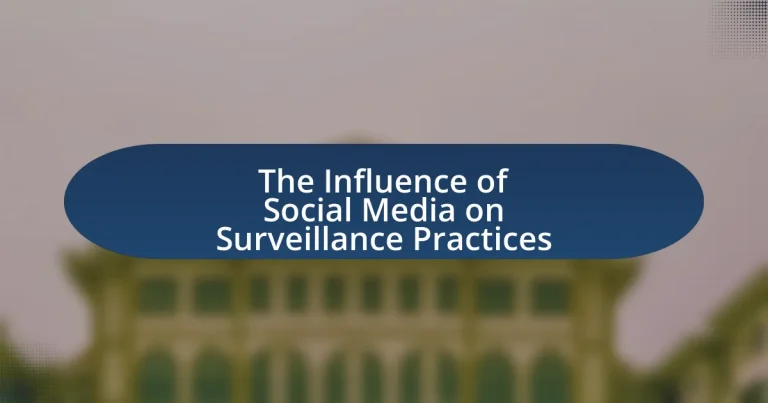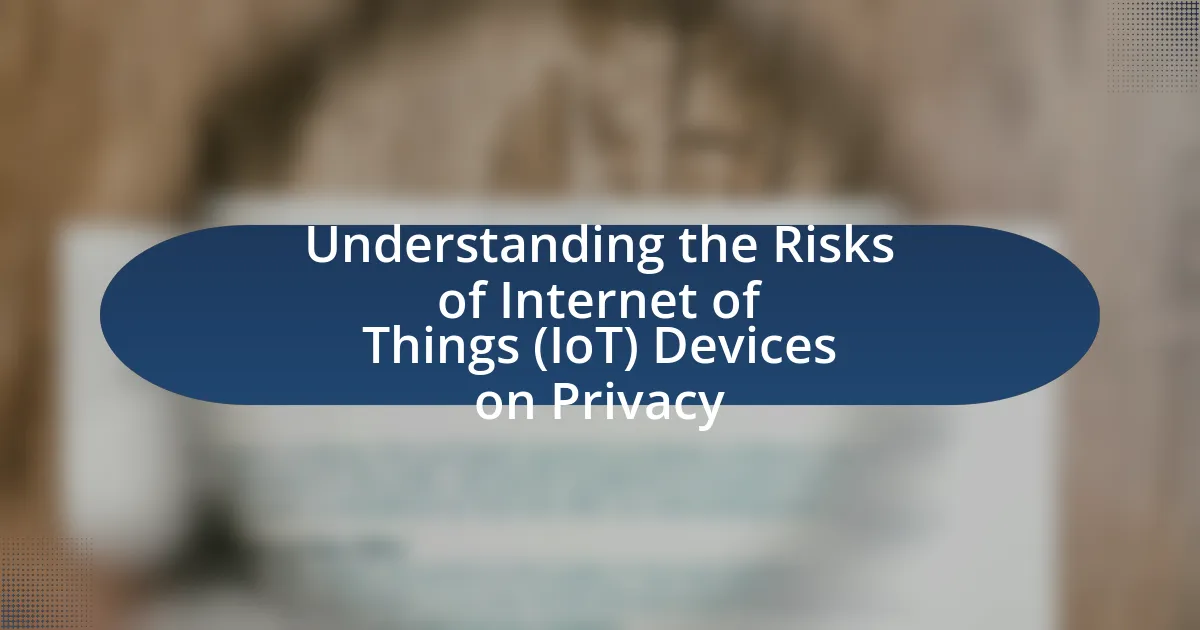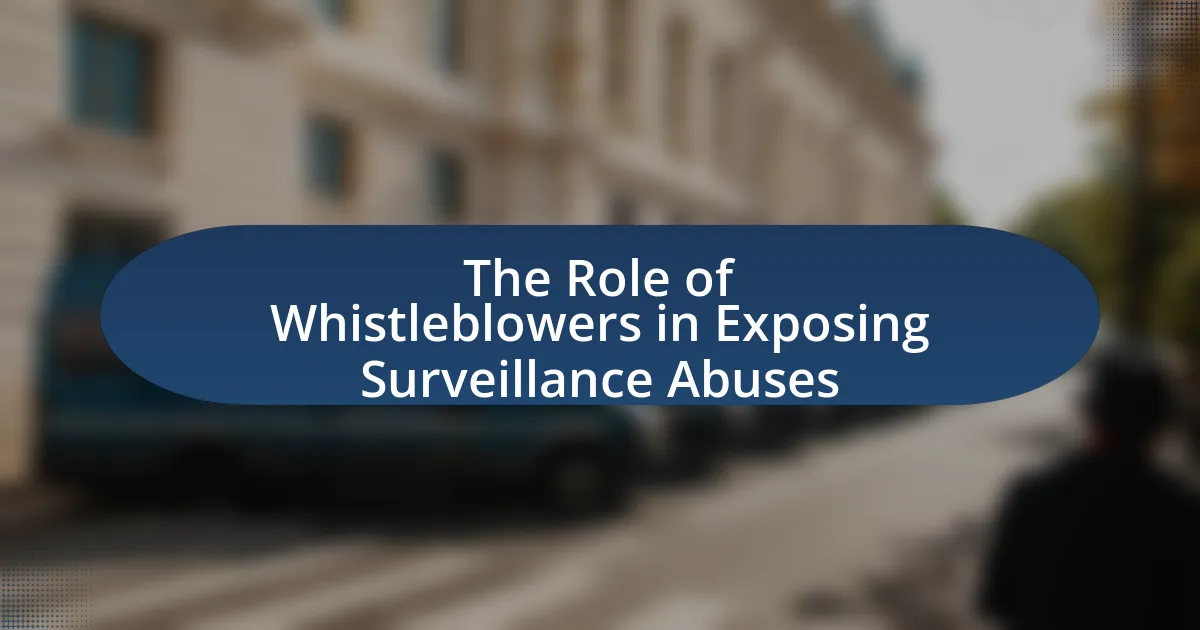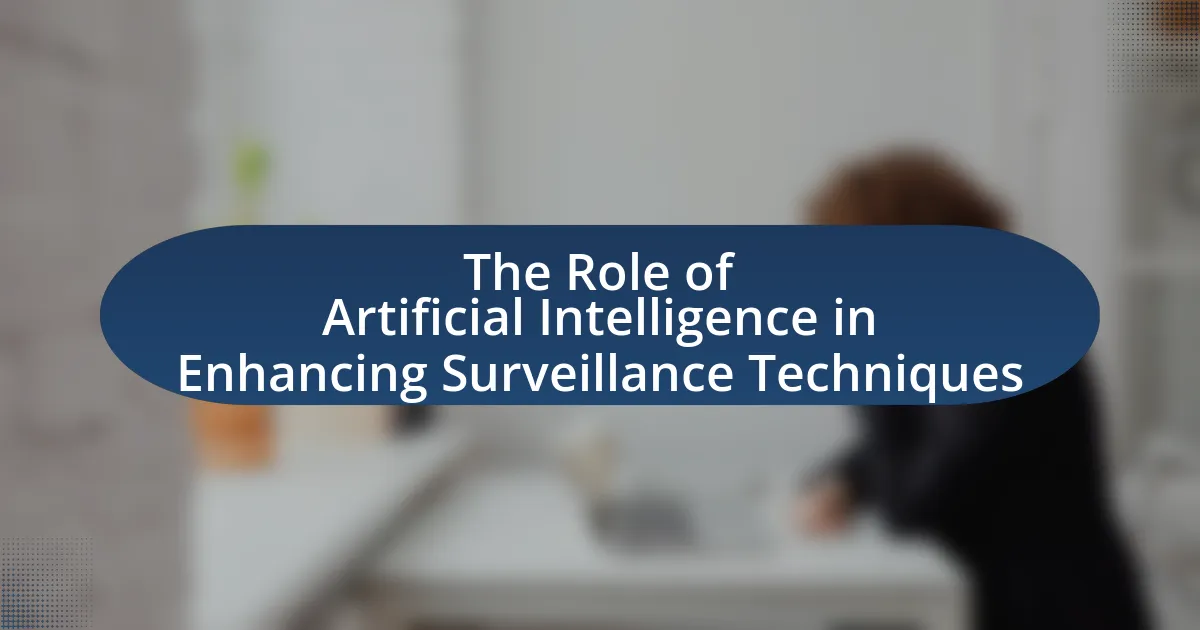The article examines the significant influence of social media on surveillance practices, highlighting how user-generated data, including personal information and location data, is utilized by both governmental and private entities for monitoring purposes. It discusses the transformation of surveillance landscapes due to real-time data collection, the key features of social media that facilitate surveillance, and the implications for privacy rights and public trust in institutions. Additionally, the article explores the role of corporations in data collection, the ethical considerations surrounding corporate surveillance, and the broader societal consequences, including impacts on social movements and individual behavior. It concludes with best practices for individuals to protect their privacy on social media platforms.
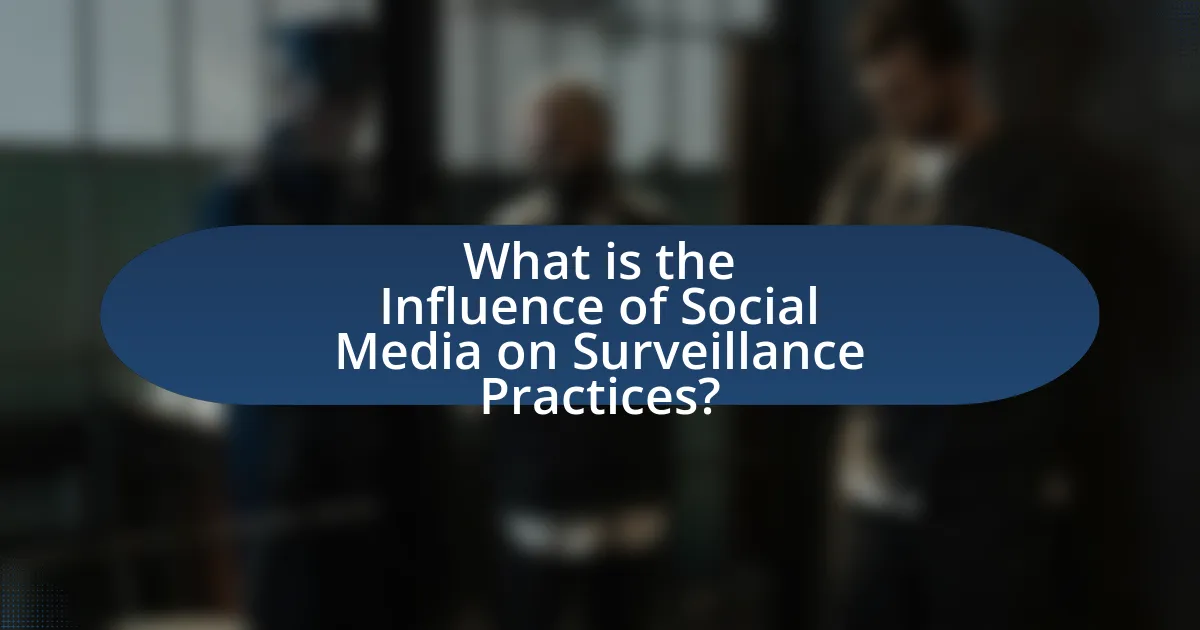
What is the Influence of Social Media on Surveillance Practices?
Social media significantly influences surveillance practices by providing vast amounts of user-generated data that can be monitored and analyzed. This data includes personal information, location data, and behavioral patterns, which are often shared publicly or semi-publicly by users. For instance, a study by the Pew Research Center found that 69% of adults in the U.S. use social media, creating a rich source of information for both governmental and private surveillance entities. Additionally, social media platforms often employ algorithms that can track user interactions and preferences, further enhancing surveillance capabilities. This integration of social media data into surveillance practices raises concerns about privacy and the potential for misuse of information.
How has social media changed the landscape of surveillance?
Social media has significantly transformed the landscape of surveillance by enabling real-time data collection and dissemination of personal information. Platforms like Facebook and Twitter allow users to voluntarily share their locations, activities, and personal thoughts, which can be monitored by both private entities and government agencies. According to a 2020 report by the Pew Research Center, 79% of Americans use social media, providing a vast pool of data that can be analyzed for surveillance purposes. This shift has blurred the lines between public and private spaces, making individuals more susceptible to surveillance without their explicit consent.
What are the key features of social media that facilitate surveillance?
The key features of social media that facilitate surveillance include user-generated content, location tracking, and data aggregation. User-generated content allows individuals to share personal information, which can be monitored and analyzed by both platforms and third parties. Location tracking features enable real-time monitoring of users’ whereabouts, providing valuable data for surveillance purposes. Data aggregation capabilities allow social media platforms to compile vast amounts of information from various sources, making it easier to analyze user behavior and identify patterns. These features collectively enhance the ability of entities to conduct surveillance on individuals and groups.
How do user-generated data contribute to surveillance practices?
User-generated data significantly enhances surveillance practices by providing real-time insights into individual behaviors and social interactions. This data, often collected from social media platforms, allows authorities and organizations to monitor public sentiment, track movements, and identify potential threats. For instance, a study by the Pew Research Center found that 69% of adults in the U.S. use social media, generating vast amounts of data that can be analyzed for patterns indicative of criminal activity or unrest. Additionally, user-generated content, such as posts and location check-ins, can be utilized to create detailed profiles of individuals, facilitating targeted surveillance efforts.
Why is understanding this influence important?
Understanding the influence of social media on surveillance practices is important because it shapes public perception, policy-making, and individual privacy rights. Social media platforms serve as significant data sources for surveillance, enabling governments and corporations to monitor behaviors and opinions. For instance, a study by the Pew Research Center found that 64% of Americans believe that the government should not be able to access their social media data without a warrant, highlighting concerns over privacy and the need for regulations. This understanding informs debates on ethical standards and legal frameworks surrounding surveillance, ensuring that individual rights are protected in an increasingly digital world.
What implications does social media surveillance have for privacy rights?
Social media surveillance significantly undermines privacy rights by enabling the collection and analysis of personal data without explicit consent. This practice allows governments and corporations to monitor individuals’ online activities, leading to potential misuse of information and erosion of personal autonomy. For instance, a 2020 report by the Electronic Frontier Foundation highlighted that over 70% of social media users are unaware of the extent to which their data is tracked and analyzed, illustrating a lack of informed consent. Furthermore, legal frameworks like the General Data Protection Regulation (GDPR) aim to protect privacy rights but often struggle to keep pace with the rapid evolution of surveillance technologies, leaving gaps that can be exploited.
How does this influence affect public trust in institutions?
The influence of social media on surveillance practices negatively affects public trust in institutions. As individuals become increasingly aware of how their data is monitored and shared through social media platforms, concerns about privacy and misuse of information grow. A 2021 Pew Research Center study found that 81% of Americans feel that the risks of data collection by companies outweigh the benefits, indicating a significant distrust in institutions that utilize surveillance technologies. This erosion of trust is further exacerbated by instances of data breaches and misuse, leading to skepticism about the intentions and transparency of governmental and corporate entities.
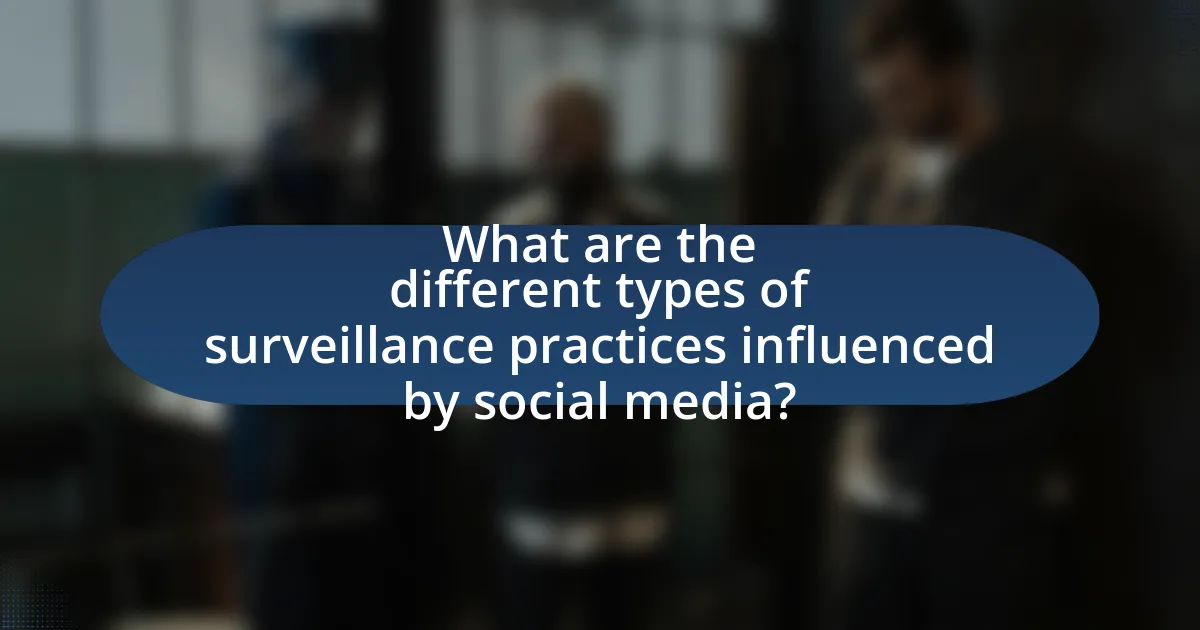
What are the different types of surveillance practices influenced by social media?
Different types of surveillance practices influenced by social media include data mining, social network analysis, and sentiment analysis. Data mining involves collecting and analyzing large sets of user-generated content to identify patterns and trends, often used by businesses for targeted advertising and by governments for monitoring public sentiment. Social network analysis examines the relationships and interactions between users, allowing for the mapping of influence and information flow within networks, which can be utilized for both marketing strategies and security purposes. Sentiment analysis assesses the emotional tone of social media posts, providing insights into public opinion and consumer behavior, which can inform decision-making in various sectors. These practices are increasingly prevalent due to the vast amount of data generated on social media platforms, enabling more sophisticated surveillance techniques.
How do governments utilize social media for surveillance?
Governments utilize social media for surveillance by monitoring user-generated content and analyzing data to track individuals and groups. This practice includes collecting information from public posts, comments, and interactions to identify potential threats, gather intelligence, and assess public sentiment. For instance, various governments employ algorithms and artificial intelligence to sift through vast amounts of social media data, enabling them to detect patterns indicative of criminal activity or unrest. Reports indicate that countries like the United States and China have implemented extensive social media monitoring programs, utilizing tools that can analyze millions of posts in real-time to inform law enforcement and national security efforts.
What tools and technologies are employed by governments for this purpose?
Governments employ various tools and technologies for surveillance practices influenced by social media, including data mining software, social media monitoring platforms, and artificial intelligence algorithms. Data mining software enables the extraction of large volumes of data from social media platforms, allowing governments to analyze user behavior and trends. Social media monitoring platforms, such as Meltwater and Brandwatch, provide real-time insights into public sentiment and discussions, facilitating targeted surveillance. Additionally, artificial intelligence algorithms enhance the ability to process and interpret vast datasets, identifying patterns and anomalies that may indicate security threats. These technologies are validated by their widespread use in national security and law enforcement agencies, as evidenced by reports from organizations like the Electronic Frontier Foundation, which highlight the increasing reliance on social media data for surveillance purposes.
How do legal frameworks shape government surveillance practices?
Legal frameworks significantly shape government surveillance practices by establishing the legal boundaries and guidelines within which surveillance can occur. These frameworks dictate the extent to which governments can monitor individuals, often balancing national security interests with citizens’ privacy rights. For instance, laws such as the USA PATRIOT Act and the Foreign Intelligence Surveillance Act in the United States provide authorities with broad surveillance powers, while also facing scrutiny and challenges regarding their implications for civil liberties. Additionally, international agreements and regulations, such as the General Data Protection Regulation (GDPR) in Europe, impose strict requirements on data collection and processing, influencing how governments implement surveillance measures. These legal structures ultimately determine the methods, scope, and oversight of surveillance activities, reflecting societal values and legal principles regarding privacy and security.
What role do corporations play in social media surveillance?
Corporations play a significant role in social media surveillance by collecting, analyzing, and monetizing user data. They utilize advanced algorithms and data analytics to track user behavior, preferences, and interactions across platforms, which enables targeted advertising and content personalization. For instance, a report by the Pew Research Center indicates that 79% of social media users are concerned about how their data is being used by companies, highlighting the pervasive nature of corporate surveillance. Additionally, corporations often collaborate with governments and law enforcement agencies, providing access to user data for security and monitoring purposes, further entrenching their role in surveillance practices.
How do companies collect and analyze user data from social media?
Companies collect and analyze user data from social media primarily through data mining techniques and analytics tools. These methods enable organizations to gather vast amounts of information, including user interactions, preferences, and demographic details. For instance, platforms like Facebook and Twitter provide APIs that allow companies to access public data, while user-generated content, such as posts and comments, can be analyzed for sentiment and trends. According to a report by Statista, in 2021, over 4.2 billion people used social media worldwide, generating a wealth of data that companies leverage for targeted marketing and product development. Additionally, companies often utilize machine learning algorithms to process this data, identifying patterns and insights that inform business strategies.
What are the ethical considerations surrounding corporate surveillance?
Corporate surveillance raises significant ethical considerations, primarily concerning privacy, consent, and data security. The practice often infringes on individuals’ right to privacy, as companies may collect extensive personal information without explicit consent. For instance, a 2020 study by the Pew Research Center found that 81% of Americans feel that the potential risks of companies collecting their personal data outweigh the benefits. Additionally, the lack of transparency in how data is used can lead to a breach of trust between corporations and consumers. Furthermore, the potential for misuse of surveillance data, such as discrimination or manipulation, poses serious ethical dilemmas. These considerations highlight the need for robust ethical frameworks and regulations to govern corporate surveillance practices.
What are the consequences of social media’s influence on surveillance practices?
Social media significantly enhances surveillance practices by providing vast amounts of user-generated data that can be monitored and analyzed. This data includes personal information, location data, and behavioral patterns, which can be utilized by both governmental and private entities for tracking individuals. For instance, a study by the Pew Research Center found that 79% of Americans are concerned about how their data is being used by companies, indicating a growing awareness of surveillance implications. Additionally, social media platforms often cooperate with law enforcement agencies, leading to increased monitoring of online activities and potential violations of privacy rights. This convergence of social media and surveillance practices raises ethical concerns regarding consent and the extent of monitoring in both public and private spheres.
How does social media surveillance impact individual behavior?
Social media surveillance significantly alters individual behavior by increasing self-censorship and altering online interactions. Individuals often modify their posts and comments to avoid negative repercussions, leading to a more curated online persona. Research indicates that 86% of social media users have adjusted their behavior due to concerns about privacy and surveillance, as highlighted in a study by the Pew Research Center. This heightened awareness of being monitored can lead to a reduction in authentic self-expression and an increase in conformity to perceived social norms.
What psychological effects does surveillance have on users?
Surveillance has significant psychological effects on users, primarily inducing feelings of anxiety, paranoia, and a decrease in trust. Users often experience heightened stress levels due to the awareness of being monitored, which can lead to self-censorship and altered behavior. Research by the American Psychological Association indicates that constant surveillance can create a sense of vulnerability, as individuals feel their privacy is compromised, leading to a decline in mental well-being. Furthermore, studies show that users may develop a distrust of institutions and technology, impacting their social interactions and overall psychological health.
How does awareness of surveillance alter user engagement on social media?
Awareness of surveillance significantly decreases user engagement on social media. Research indicates that when users are conscious of being monitored, they tend to modify their behavior, often opting for more private settings or reducing their overall activity. A study by the Pew Research Center found that 86% of Americans have taken steps to avoid surveillance, such as using privacy settings or limiting their online sharing. This heightened awareness leads to a more cautious approach, resulting in decreased interaction, sharing, and overall engagement on platforms where users feel their privacy is compromised.
What are the broader societal implications of social media surveillance?
Social media surveillance has significant broader societal implications, including the erosion of privacy, the potential for increased social control, and the amplification of misinformation. The erosion of privacy occurs as individuals’ personal data is continuously monitored and analyzed, leading to a culture of self-censorship where users may alter their behavior due to fear of being watched. This phenomenon is supported by a 2020 study from the Pew Research Center, which found that 81% of Americans feel that the risks of sharing personal information on social media outweigh the benefits.
Increased social control is another implication, as governments and corporations can leverage surveillance data to influence public opinion and behavior, potentially leading to authoritarian practices. For instance, the use of social media data by law enforcement agencies for predictive policing has raised concerns about racial profiling and discrimination.
Furthermore, the amplification of misinformation is exacerbated by surveillance practices, as algorithms prioritize sensational content, which can distort public discourse and undermine democratic processes. A 2021 report from the Oxford Internet Institute highlighted that social media platforms often facilitate the rapid spread of false information, impacting elections and public health responses. These implications collectively highlight the profound effects of social media surveillance on societal norms and democratic values.
How does surveillance affect social movements and activism?
Surveillance significantly impacts social movements and activism by creating an environment of fear and self-censorship among activists. When individuals know they are being monitored, they may alter their behavior, reducing participation in protests or discussions to avoid repercussions. For instance, the use of facial recognition technology during protests has been documented to deter participation, as seen in the 2019 Hong Kong protests, where activists expressed concerns about being identified and arrested. Additionally, surveillance can lead to the targeting of specific individuals or groups, undermining the collective strength of movements. Research by the Electronic Frontier Foundation highlights that increased surveillance correlates with a decline in public dissent, as activists become wary of potential legal consequences or social backlash.
What are the potential risks of normalizing surveillance in society?
Normalizing surveillance in society poses significant risks, including the erosion of privacy, increased state control, and the potential for abuse of power. The erosion of privacy occurs as individuals become accustomed to constant monitoring, leading to a diminished expectation of personal space and confidentiality. Increased state control can manifest through the normalization of surveillance technologies, which governments may exploit to monitor citizens without accountability. Furthermore, the potential for abuse of power is evident in historical instances where surveillance has been used to target dissenters, as seen in authoritarian regimes that utilize surveillance to suppress opposition. These risks highlight the dangers of integrating surveillance into everyday life, as they can undermine democratic values and individual freedoms.
What best practices can individuals adopt to protect their privacy on social media?
Individuals can protect their privacy on social media by adjusting their privacy settings, limiting personal information sharing, and being cautious about friend requests. Adjusting privacy settings allows users to control who can see their posts and personal information, significantly reducing exposure to unwanted surveillance. Limiting personal information sharing, such as avoiding the posting of sensitive details like location or contact information, minimizes the risk of data misuse. Additionally, being cautious about friend requests helps prevent connections with potential malicious actors, thereby safeguarding personal data. According to a 2021 Pew Research Center study, 64% of social media users have adjusted their privacy settings to limit data exposure, highlighting the effectiveness of these practices.
How can users manage their privacy settings effectively?
Users can manage their privacy settings effectively by regularly reviewing and adjusting their account settings on social media platforms. This includes enabling privacy features such as two-factor authentication, limiting profile visibility to friends only, and controlling who can see posts and personal information. According to a 2021 Pew Research Center study, 81% of Americans feel they have little to no control over the data collected by companies, highlighting the importance of proactive management of privacy settings to mitigate surveillance risks.
What tools are available to enhance privacy on social media platforms?
Tools available to enhance privacy on social media platforms include end-to-end encryption, privacy-focused browser extensions, and settings for account privacy. End-to-end encryption, utilized by platforms like WhatsApp, ensures that only the communicating users can read the messages, preventing unauthorized access. Privacy-focused browser extensions, such as Privacy Badger and uBlock Origin, block trackers and ads that compromise user privacy while browsing social media. Additionally, users can adjust their account privacy settings to limit who can view their profiles and posts, thereby controlling their personal information exposure. These tools collectively contribute to a more secure social media experience by safeguarding user data against surveillance practices.
